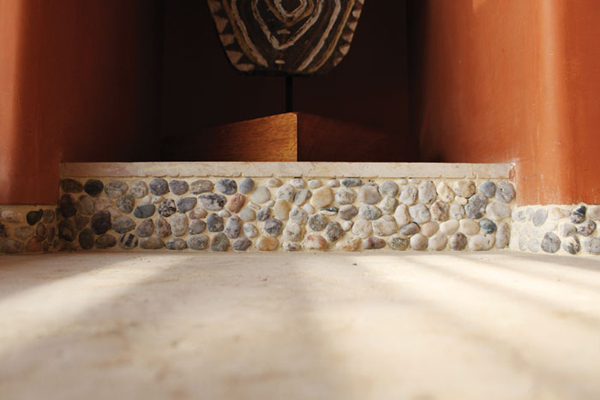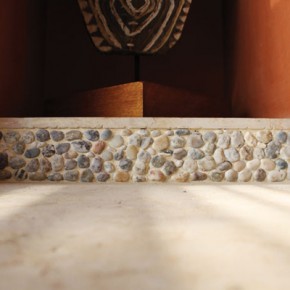Flooring may be the last thing you think of when it comes to building a home, but it’s usually the first thing to make an impression upon entering your home.
The first step towards a beautifully finished interior is deciding on a floor that is both appropriate for your budget and fits with your interior décor. The material, color and texture of your flooring will help bring together other elements of your interior, creating a living space that is always a pleasure to come home to. The best floor finishing options are ones that will both stand the test of time and reflect the beauty of Zihuatanejo and our natural surroundings.
Marble
Mexico is a veritable cornucopia when it comes to marble and travertine stone. The material itself comes in a nice variety of warm colors that blend marvelously well in our coastal environs. In addition to its elegance and durability, stone flooring reflects heat, acting as a natural coolant in our tropical climate. Marble and stone can be installed as slabs or tiles, custom cut to flooring specifications. Each marble tile is bonded together by a very thin mortar, which gives the flooring a nice uniform look.
Marble and stone flooring and be finished in many different ways, including sand blasted, honed, brushed, polished, etc. The different finishes produce either a smoother or more roughly textured surface, which can then be sealed in high gloss, semi-gloss or matte, depending on the interior look you want to achieve. Characteristically a porous and fine material, marble is susceptible to stains and marks especially from any kind of acid based liquid or cleaning product. Raw marble tiles will also start to wear away over time and with daily foot-traffic. However, properly sealed, marble and stone flooring can be very durable, stain resistant and lasting, making for very easy ongoing cleaning and maintenance.
Tile
Tile making is a long-standing tradition in Mexico with its history rooted in a rich mixture of Spanish, Moroccan and Asian design influence. There are many different styles of hand-crafted Mexican tile and many different regions where tile is manufactured. Terracotta or “baked earth” tiles are what is commonly seen in homes throughout Mexico, Spain and the Mediterranean. Typically known as Saltillo tile, this rich, earthy textile imparts a warm rustic look that no other material can match. Each hand-made tile varies slightly in color and shape, giving it a unique character and appeal. These natural variations also make terracotta tiles more labor intensive to install, however there is no limit to the imagination when it comes to intricate floor designs and inlays.
Talavera tiles are typically smaller, glazed and more ornate tiles made of ceramic, which are seen in the back splashes of most traditional Mexican kitchens. However, they can also be used in flooring as border details or decorative inlays and there is a plethora of multi-colored patterns and designs to choose from. Unlike marble however, clay tiles are somewhat less durable and over time are more susceptible to cracks and upheaval from water and humidity. As with most any other flooring, sealant should be applied to both the tiles and grout to properly protect the flooring against everyday ware and tear.
Concrete
While most of us may be used to the idea of poured concrete for driveways, patios and walkways, concrete is another readily available material ideal for interior flooring. Concrete is one of the few materials that can be customized in just about every aspect, giving you unlimited range in color, shape, thickness and texture.
Concrete can be laid as smooth polished slabs, textured tiles or in any array of architecture designs. Once installed, concrete requires minimal ongoing maintenance and is generally an easy to clean surface. Properly mixed, poured and sealed concrete flooring can last for years and experience minimal cracking or erosion.
Hardwood
There is probably nothing that has quite the signature beauty of a hardwood floor. Here in the tropics, while an uncommon site, hardwood can be a lasting and durable flooring option. When shopping for hardwood flooring, it’s important to choose above grade materials, as floorboards grade or below have a tendency to bow and buckle due from the high moisture levels here.
Laminate flooring materials that look like hardwood should be avoided as they are not made to withstand moisture and humidity of the tropics. Make sure to choose a professional installer who has plenty of experience with local installations as there are different factors to consider when living this close to the coast.
Bamboo
If you are looking for an eco-friendly alternative to hardwood flooring, then consider bamboo. Bamboo is both versatile and easily harvested and replenished in just about anywhere in the world. Bamboo does not shrink and swell like hardwoods, making it a very stable flooring material. It’s also denser than your average hardwood, making it more resistant to the everyday ware.
Bamboo flooring is typically structured using strands of bamboo that have been compressed and bonded together. The finished look can either simulate that of traditional hardwood or for a wilder, exotic and tropical look there are mixed strand options that combine bamboo of different shades and color.
Baseboard and Detailing
Depending on what type of flooring you opt for, you may also consider adding a baseboard and/or kick plates to certain areas of your interior. Smooth and colored river pebbles are often used as a baseboard along the edges of marble or concrete flooring. They can also serve to add decorative detailing and floor medallions that may delineate living or dining spaces and serve as non-slip flooring in showers and baths. It’s important to choose stones that will be easy on the feet if you plan to use these materials anywhere you are not likely to be using footwear.
Small marble tiles are also commonly used to form a baseboard, providing a cleaner and more modern look. You may also consider using marble tiles for kick plates under kitchen and bath counters as they are more scuff resistant, especially if you have pasta finishes for your interior wall covering. These are typically high-traffic areas that often get overlooked when adding a baseboard to your interior décor.
Maintenance
It’s important to remember that whatever flooring you decide on, the best way to keep it looking good is by applying a quality sealant and when cleaning or mopping, avoiding harsh chemical or acid-based cleaning products whenever possible. If your flooring becomes dull over time, you can always use a fine-grit abrasive to remove the existing sealant and lightly re-polish for best results.
-
Interior Finishing: Flooring
-
Interior Finishing: Flooring
-
Interior Finishing: Flooring
-
Interior Finishing: Flooring
- Interior Finishing: Flooring
- Interior Finishing: Flooring
- Interior Finishing: Flooring
- Interior Finishing: Flooring








